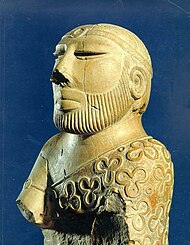
Back تاريخ السند Arabic Sind tarixi Azerbaijani Història del Sind Catalan सिन्ध का इतिहास Hindi Sindho istorija Lithuanian История Синда Russian سنڌ جي تاريخ Sindhi Historija Sindha Serbo-Croatian சிந்துவின் வரலாறு Tamil سندھ کی تاریخ Urdu
| History of Sindh |
|---|
 |
| History of Pakistan |
| History of Pakistan |
|---|
 |
| Timeline |
The history of Sindh refers to the history of the Pakistani province of Sindh, as well as neighboring regions that periodically came under its sway.
Sindh was the site of one of the Cradle of civilizations, the Bronze Age Indus Valley civilisation that flourished from about 3000 B.C. and declined rapidly 1,000 years later, following the Indo-Aryan migrations that overran the region in waves between 1500 and 500 B.C.[1] The migrating Indo-Aryan tribes gave rise to the Iron Age vedic civilization, which lasted till 500 BC. During this era, the Vedas, the oldest and primary Hindu scriptures were composed. In 518 BC, the Achaemenid empire conquered Indus valley and established Hindush satrapy in Sindh. Following Alexander the Great's invasion, Sindh became part of the Mauryan Empire. After its decline, Indo-Greeks, Indo-Scythians and Indo-Parthians ruled in Sindh.
Sindh is sometimes referred to as the Bab-ul Islam (transl. 'Gateway of Islam'), as it was one of the first regions of the Indian subcontinent to fall under Islamic rule. Parts of the modern-day province were intermittently subject to raids by the Rashidun army during the early Muslim conquests, but the region did not fall under Muslim rule until the Arab invasion of Sind occurred under the Umayyad Caliphate, headed by Muhammad ibn Qasim in 712 CE.[2][3] Afterwards, Sindh was ruled by a series of dynasties including Habbaris, Soomras, Sammas, Arghuns and Tarkhans. The Mughal empire conquered Sindh in 1591 and organized it as Subah of Thatta, the first-level imperial division. Sindh again became independent under Kalhora dynasty. The British conquered Sindh in 1843 AD after Battle of Hyderabad from the Talpur dynasty. Sindh became separate province in 1936, and after independence became part of Pakistan.
Sindh is home to two UNESCO-designated World Heritage Sites: the Makli Necropolis and Mohenjo-daro.[4]
- ^ Minahan, James (2012). Ethnic Groups of South Asia and the Pacific: An Encyclopedia. ABC-CLIO. pp. 257–259. ISBN 978-1-59884-659-1.
- ^ Quddus, Syed Abdul (1992). Sindh, the Land of Indus Civilisation. Royal Book Company. ISBN 978-969-407-131-2.
- ^ JPRS Report: Near East & South Asia. Foreign Broadcast Information Service. 1992.
- ^ "Properties inscribed on the World Heritage List (Pakistan)". UNESCO. Retrieved 14 July 2016.
© MMXXIII Rich X Search. We shall prevail. All rights reserved. Rich X Search